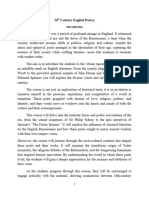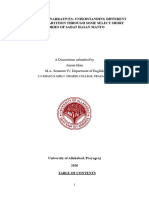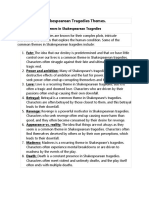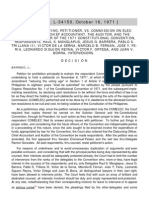Development of English Drama
Development of English Drama
Uploaded by
Rangothri Sreenivasa SubramanyamCopyright:
Available Formats
Development of English Drama
Development of English Drama
Uploaded by
Rangothri Sreenivasa SubramanyamOriginal Description:
Copyright
Available Formats
Share this document
Did you find this document useful?
Is this content inappropriate?
Copyright:
Available Formats
Development of English Drama
Development of English Drama
Uploaded by
Rangothri Sreenivasa SubramanyamCopyright:
Available Formats
Assignment
On
History of English literature
Sub: development of English drama from Middle time to Elizabethan time
Course code: ENGL-104 Submitted to: Shampa iftekher Lecturer of English department Stamford university Bangladesh Submitted by: Shahadat hossain ID. No. ENG-04406267 Bachelor of art in English (honors) Stamford university Bangladesh Date of submission 10, march, 2011.
Development of English drama from Middle time to Elizabethan time.
The allegorical morality play, a type of nonliturgical vernacular religious drama, was one of the forerunners to the development of English drama. English drama developed out of early non liturgical vernacular religious dramas, which had themselves probably developed out of the liturgical drama of the medieval church. Though secularized, these early dramatic forms" "the mystery, miracle, and morality plays" "still focused on the religious and moral themes that dominated the Christian imagination during the Middle Ages. The mystery plays dramatized sacred history, representing events from Creation to Judgment Day. Miracle plays presented the lives and miracles of the saints, or episodes of divine intervention in human affairs, often through the agency of the Virgin Mary. Unlike the perspective of the mystery and miracle plays, that of the morality play was individual rather than collective. The morality play (usually called simply a "morality") presented religious and ethical concerns from the point of view of the individual Christian, whose main concern was to effect the salvation of his soul. The mystery and miracle plays developed first, around 1100 a.d. Late in the fourteenth century, morality plays on such subjects as the seven deadly sins became popular in France, England and the Netherlands. In the first decades of the fifteenth century, secular allegorical plays concerning the conflict between good and evil in the individual soul began to be performed in France by law clerks and students, and this type of play soon became popular all over Europe, including England. A morality play is essentially an allegory in dramatic form. It shares the key features of allegorical prose and verse narratives: it is intended to be understood on two or more levels, its main purpose is didactic, and the characters are personified abstractions with aptronyms ("label names"). The nondramatic didactic and allegorical precursors to the morality play are to be found in medieval sermon literature, homilies, exempla, fables, parables, and other works of moral or spiritual edification, as well as in the popular romances of medieval Europe. Another dramatic form that has much in common with the morality play is the interlude, particularly that subset of interludes called "moral interludes." There is no clear dividing line between the moral interlude and the morality play, and in fact many works are classified under both headings: "The Pride of Life (c. 1300), "The Castell of Perseverance" (c. 1400), "Wisdom" (c. 1460), "Mankind" (c. 1465), "Hyckescorner" (1512), "Lusty Juventus" (1550), and "Like Will to Like" (1568). Moral interludes were usually about 1000 lines long and written in rough verse""often mere doggerel. Interludes generally, including moral interludes, were often written to be performed as entertainments at court, in the houses of nobility, at University colleges, and at the Inns of Court.
Typically, the morality play is a psychomachia, an externalized dramatization of a psychological and spiritual conflict: the battle between the forces of good and evil in the human soul. This interior struggle involves the Christian's attempt to achieve salvation, despite the obstacles and temptations that he encounters as he travels through life, toward death. Originally, because of their roots in religious drama and their didactic purpose, moralities were serious in tone and style, but the increasing secularization of the plays led to the incorporation of elements derived from popular farce, a process encouraged by the presentation of the Devil and his servant the Vice as boisterous mischief-makers. These characters soon became figures of amusement rather than of moral edification. Even more disturbing for the Church was the way that actors would improvise humorous""and often ribald""scenes to increase the crowd's hilarity. By about 1500 the Church no longer officially approved of the mystery and miracle plays or the morality plays, and in England they were suppressed after the Reformation in the sixteenth century, though they continued to be performed well into the seventeenth century in the Catholic countries of Europe. In England the moralities dramatized the progress of the Christian's life from innocence to sin, and from sin to repentance and salvation. Among the most widely known of the fifteenth-century moralities are "The Castell of Perseverance," which features a battle between Virtues and Vices; "Mankind," which incorporates topical farce; and perhaps the most famous of all the English morality plays, "Everyman" (c. 1495), which concerns the Christian's experience of mortality and Judgment. The main characters in "Everyman" are God, a Messenger, Death, Everyman, Fellowship, Kindred, Cousin, Goods, Knowledge, Beauty, Strength, and Good Deeds. Everyman is immersed in worldly pleasures when Death summons unexpectedly him. He soon finds that none of his supposedly loyal companions (Fellowship, Kindred, Cousin) will go with him. His treasured Goods also desert him, and at the grave the qualities of the flesh (Beauty, Strength) also fade away. Only Good Deeds stays with him to help him get into Paradise, which is accomplished with the help and guidance of Knowledge, by means of Confession and Priesthood. In other moralities, various manifestations of the forces of Evil (the Seven Deadly Sins, the World, the Flesh, the Devil, Vice) are arrayed against the Christian, who turns for help to the forces of Good (God, His angels, Virtue). The quality of writing in the moralities is uneven, and in many cases the author is unknown. Characterization is also crude and nave, and there is little attempt to portray psychological depth. But over time, the moralities began to show signs of increasingly sophisticated analysis of character. This increasing subtlety and depth of characterization point directly to the development of mainstream Elizabethan and Jacobean drama. Thomas Sackville and Thomas Norton's play "Gorboduc," the first of the Elizabethan tragedies, is a kind of political morality play on the proper government of a kingdom. And at least one of drama's most memorable characters, Shakespeare's Falstaff, is a direct descendant of the
medieval Vice. Falstaff functions as a Vice not only in his character, but also in the way he tempts Prince Hal in "Henry IV" (Parts I and II) to neglect his duties as heir apparent to the English throne in order to pursue a life of drunkenness, wantonness, and crime. When Hal becomes king, he must repudiate Falstaff altogether, just as the Christian must repudiate Vice in the medieval morality play. By the sixteenth century, morality plays were addressing not only religious themes, but also social and political analysis and satire. For example, "Magnificence: (1516) satirizes extravagance, and "Satyre of the Three Estaitis" (1540) is a political morality play. From about the mid-sixteenth century, under increasing pressure from religious authorities, the popularity of the moralities began to wane, but they continued to be a major influence on mainstream drama. Besides Sackville and Norton's "Gorboduc," Nathaniel Wood's "The Conflict of Conscience" (1568) and Christopher Marlowe's "The Tragical History Of Dr. Faustus" (1588) also owe much to the morality play, and even as late as 1625, Ben Jonson's "The Staple of News" showed the influence of the moralities, especially in Lady Pecunia, an allegorical character representing Riches. The allegorical use of aptronyms for characters in seventeenth- and eighteenth-century comedies, and also in novels and short stories all through he nineteenth and twentieth centuries, suggests the ongoing significance of the tradition established by the morality play.
You might also like
- Characteristics of 16th Century English PoetryDocument3 pagesCharacteristics of 16th Century English Poetrydara Hinari100% (2)
- Gayathri Mantra in TeluguDocument18 pagesGayathri Mantra in Teluguramu0510100% (3)
- Reading Rape: Sexual Difference, Representational Difference, and Narrative Containment - Self Study NotesDocument4 pagesReading Rape: Sexual Difference, Representational Difference, and Narrative Containment - Self Study NotesSatheesh Viswamm100% (1)
- Rules of Concord or SubjectDocument3 pagesRules of Concord or SubjectRangothri Sreenivasa Subramanyam33% (3)
- Horace Levinson - Chance, Luck, and StatisticsDocument371 pagesHorace Levinson - Chance, Luck, and StatisticsMarc100% (2)
- Small Talk, Presentation Skills and Business MeetingsDocument20 pagesSmall Talk, Presentation Skills and Business MeetingsNikita SangalNo ratings yet
- The Crucible Casting ProjectDocument4 pagesThe Crucible Casting Projectapi-375304629No ratings yet
- (Brill's Companions To The Christian Tradition, 38) Irven Resnick - A Companion To Albert The Great - Theology, Philosophy, and The Sciences-BRILL (2012)Document850 pages(Brill's Companions To The Christian Tradition, 38) Irven Resnick - A Companion To Albert The Great - Theology, Philosophy, and The Sciences-BRILL (2012)Paulo Sergio Mendoza Gurrola100% (5)
- Renaissance DramaDocument5 pagesRenaissance Dramarosmery15No ratings yet
- Modern English Drama 2024 DR RafeaDocument6 pagesModern English Drama 2024 DR Rafeazyzz3690No ratings yet
- The Gothic Novel: Novelists of The Romantic AgeDocument2 pagesThe Gothic Novel: Novelists of The Romantic AgeIntezar Lahasil0% (1)
- Classics in Drama: Art and Artifice of Shakespearean TragedyDocument10 pagesClassics in Drama: Art and Artifice of Shakespearean TragedyMuhammad Hashir Aziz100% (1)
- A Psychological Study of Nathaniel Hawthorne'S The: Scarlet LatterDocument10 pagesA Psychological Study of Nathaniel Hawthorne'S The: Scarlet LatterRomilyn PiocNo ratings yet
- Characteristics of Romantic RevivalDocument4 pagesCharacteristics of Romantic Revivalgohilharsh0451No ratings yet
- Ben JonsonDocument45 pagesBen JonsonRamachandran RajaramNo ratings yet
- Analysis of Sonnet 30Document1 pageAnalysis of Sonnet 30Katelin LucineNo ratings yet
- The Novel of Manners Samuel RichardsonDocument9 pagesThe Novel of Manners Samuel RichardsonAmalia BodeaNo ratings yet
- A Dialogue of Self and SoulDocument4 pagesA Dialogue of Self and SoulAwais TareqNo ratings yet
- EcstasyDocument5 pagesEcstasyanmansariNo ratings yet
- Taine's FormulaDocument1 pageTaine's Formulajunaid ashrafNo ratings yet
- Difference Between Jacobean Drama and Elizabethan DramaDocument3 pagesDifference Between Jacobean Drama and Elizabethan DramaBiotechnologistNo ratings yet
- Significance of The Title of Arms and The Man by Bernard ShawDocument2 pagesSignificance of The Title of Arms and The Man by Bernard Shawgiridipak84No ratings yet
- Contribution of Ben JohnsonDocument17 pagesContribution of Ben JohnsonSomapti Das0% (1)
- ImagismDocument2 pagesImagismTahirullah KhanNo ratings yet
- Formalism Presentation 01Document6 pagesFormalism Presentation 01DDC RYKNo ratings yet
- Elizabethan Revenge Tragedy: An OutlineDocument4 pagesElizabethan Revenge Tragedy: An Outlinetvphile1314No ratings yet
- Ahmed Ali A WriterDocument7 pagesAhmed Ali A WriterjiaNo ratings yet
- The Way of The World PowerPoint Presentation SSDocument15 pagesThe Way of The World PowerPoint Presentation SSmorebandu2483No ratings yet
- Salient Features of Elizabethan PoetryDocument2 pagesSalient Features of Elizabethan PoetrySajidaNo ratings yet
- Snake-Explanation and ThemesDocument16 pagesSnake-Explanation and Themesdeviljoy001No ratings yet
- Forms of DramaDocument2 pagesForms of Dramaarshad tararNo ratings yet
- Sadat Hasan Manto: DissertationDocument23 pagesSadat Hasan Manto: DissertationheraNo ratings yet
- Industrial Revolution: How It Effect Victorian Literature in A Progressive or Adverse WayDocument2 pagesIndustrial Revolution: How It Effect Victorian Literature in A Progressive or Adverse WaydjdmdnNo ratings yet
- The Deconstructive AngelDocument3 pagesThe Deconstructive Angelgandhimathi2013100% (1)
- Romantic Till Modern PoetryDocument17 pagesRomantic Till Modern PoetryAhmad Aqeel Sarwar100% (2)
- Alliterative Poems of Middle English PeriodDocument6 pagesAlliterative Poems of Middle English PeriodTaibur RahamanNo ratings yet
- Joseph AndrewsDocument18 pagesJoseph AndrewsZia Ullah100% (1)
- Trends and Tecniques in Modern English DramaDocument5 pagesTrends and Tecniques in Modern English DramaS KNo ratings yet
- Campus NovelDocument2 pagesCampus NovelYusuf Ziyaettin Turan100% (2)
- Twentieth Century DramaDocument4 pagesTwentieth Century DramaArchana MehraNo ratings yet
- Elizabethan TragedyDocument1 pageElizabethan TragedyTaibur Rahaman0% (1)
- Sketch The Character of Mephistopheles and MoreDocument7 pagesSketch The Character of Mephistopheles and MoreDevika SNo ratings yet
- Jane Austen-Main Features of Her WritingDocument7 pagesJane Austen-Main Features of Her WritingCecilia KennedyNo ratings yet
- William Shakespeare: Brief IntroductionDocument30 pagesWilliam Shakespeare: Brief IntroductionNajd MhammdNo ratings yet
- What Is A Pastoral PoemDocument3 pagesWhat Is A Pastoral PoemJoan Manuel SorianoNo ratings yet
- Themes in Shakespearean TragediesDocument2 pagesThemes in Shakespearean TragediesArshad MunirNo ratings yet
- The Tragic Drama of Doctor FaustusDocument12 pagesThe Tragic Drama of Doctor FaustustigerpiecesNo ratings yet
- Satire and Types (Representatives) In: Joseph AndrewsDocument24 pagesSatire and Types (Representatives) In: Joseph AndrewsDina Hussein Badr abdelmaksoud ١٩١٠٢٩٦٥100% (1)
- Revenge TragedyDocument1 pageRevenge TragedyRaihan AliNo ratings yet
- ChaucerDocument22 pagesChaucerZeeshanAhmad100% (1)
- Important QuestionsDocument2 pagesImportant QuestionsAmbarNo ratings yet
- Volpone by Ben JonsonDocument5 pagesVolpone by Ben JonsonSenay SevenNo ratings yet
- Ode To Duty by William WordsworthDocument7 pagesOde To Duty by William Wordsworthsandip pandeyNo ratings yet
- The University Wits - Easy EnglishDocument3 pagesThe University Wits - Easy EnglishNayan BhuiNo ratings yet
- My Notes On Victorian Crisis of Faith in Tennyson and ArnoldDocument2 pagesMy Notes On Victorian Crisis of Faith in Tennyson and ArnoldPriyanka DasNo ratings yet
- English Tintern AbbeyDocument29 pagesEnglish Tintern AbbeyJagruti Nirav100% (1)
- Characteristics of TragicomedyDocument3 pagesCharacteristics of TragicomedyHari Sakhra100% (1)
- The Development of English Poetry in English Literature: STBA LIA Yogyakarta 2020Document40 pagesThe Development of English Poetry in English Literature: STBA LIA Yogyakarta 2020Farhan Adriansyah GianisNo ratings yet
- Elizabethan ProseDocument2 pagesElizabethan ProseAdeelBaig100% (1)
- Catherine Belsey S Critical Practice A Critical AnalysisDocument43 pagesCatherine Belsey S Critical Practice A Critical AnalysisNayana Thampi100% (5)
- What Are The Characteristics of Alexander PopeDocument2 pagesWhat Are The Characteristics of Alexander Popevidhya.prasaiNo ratings yet
- University WitsDocument3 pagesUniversity WitsSAHIN AKHTAR100% (1)
- Elizabethan TheatreDocument3 pagesElizabethan TheatrebecciNo ratings yet
- Study Guide to The Homecoming and Other Works by Harold PinterFrom EverandStudy Guide to The Homecoming and Other Works by Harold PinterNo ratings yet
- Unit V Reading Comprehension FinalDocument14 pagesUnit V Reading Comprehension FinalRangothri Sreenivasa SubramanyamNo ratings yet
- Unit VI RS Letter Writing FinalDocument26 pagesUnit VI RS Letter Writing FinalRangothri Sreenivasa Subramanyam100% (1)
- Abraham Hicks QuotesDocument10 pagesAbraham Hicks QuotesKeyaraMalika100% (2)
- Kundalini Breathing ExerciseDocument2 pagesKundalini Breathing ExerciseAbdRdr63100% (4)
- RS Unit VI Paragraph Writing FinalDocument7 pagesRS Unit VI Paragraph Writing FinalRangothri Sreenivasa SubramanyamNo ratings yet
- Activating Vocaulary Through PicturesDocument25 pagesActivating Vocaulary Through PicturesRangothri Sreenivasa SubramanyamNo ratings yet
- The Directors - Take FourDocument241 pagesThe Directors - Take FourBogdan Theodor Olteanu100% (2)
- Gita For AwakeningDocument300 pagesGita For AwakeningLokesh KhuranaNo ratings yet
- ASHAMASHI (Telugu Kaburulu)Document122 pagesASHAMASHI (Telugu Kaburulu)Rangothri Sreenivasa SubramanyamNo ratings yet
- Adjective Clauses Review Ex Answer KeyDocument5 pagesAdjective Clauses Review Ex Answer KeyRangothri Sreenivasa SubramanyamNo ratings yet
- Easier English Basic SynonymsDocument129 pagesEasier English Basic SynonymsRangothri Sreenivasa SubramanyamNo ratings yet
- KOUMUDI - 2015 - HASYAVALLARI TeluguDocument51 pagesKOUMUDI - 2015 - HASYAVALLARI TeluguRangothri Sreenivasa Subramanyam100% (1)
- Ahankaar - Mimansha in HindiDocument243 pagesAhankaar - Mimansha in HindiRangothri Sreenivasa SubramanyamNo ratings yet
- Koumudi - Sramanakam TeluguDocument152 pagesKoumudi - Sramanakam TeluguRangothri Sreenivasa SubramanyamNo ratings yet
- W3 U3 L13.Controlling Negative Emotions Managing AngerDocument13 pagesW3 U3 L13.Controlling Negative Emotions Managing AngerRangothri Sreenivasa SubramanyamNo ratings yet
- W3 U2 L12.Assertiveness 3 How To Say NoDocument11 pagesW3 U2 L12.Assertiveness 3 How To Say NoRangothri Sreenivasa Subramanyam100% (1)
- The Death (S) of Cinema According To GodardDocument16 pagesThe Death (S) of Cinema According To GodardJeeyeon YuNo ratings yet
- Art Appreciation Lesson 5Document66 pagesArt Appreciation Lesson 5Khrystinne Jem RoseteNo ratings yet
- Tolentino v. Comelec, GR L-34150 Oct. 16, 1971Document23 pagesTolentino v. Comelec, GR L-34150 Oct. 16, 1971Tin SagmonNo ratings yet
- The Entrepreneurial Marketing Mix PDFDocument13 pagesThe Entrepreneurial Marketing Mix PDFLeilani De GuzmanNo ratings yet
- Water SluiceDocument56 pagesWater SluicekkyushiNo ratings yet
- CERTIFICATEDocument5 pagesCERTIFICATEArchie SrivastavaNo ratings yet
- Aus Bibliography On Event ManagementDocument36 pagesAus Bibliography On Event ManagementGeethu Mary GeorgeNo ratings yet
- Self-Renewal The Pillar of StrengthDocument10 pagesSelf-Renewal The Pillar of Strengthmuralimohanrao rojukurthiNo ratings yet
- Planning For A Doctoral ThesisDocument6 pagesPlanning For A Doctoral Thesisronald alexNo ratings yet
- Dalberg Case Study CompetitionDocument2 pagesDalberg Case Study CompetitionDuttatreya DasNo ratings yet
- Behaviorism, Private Events, and The Molar View of BehaviorDocument16 pagesBehaviorism, Private Events, and The Molar View of Behaviorjoao1504No ratings yet
- How To Get IELTS Band 8.0 or 8.5Document3 pagesHow To Get IELTS Band 8.0 or 8.5Yasmine El SherbinyNo ratings yet
- Mpa 011-014Document4 pagesMpa 011-014lal91No ratings yet
- Some People Say History Is One of The Most Important SubjectDocument1 pageSome People Say History Is One of The Most Important SubjectOSAMA BAKHITNo ratings yet
- Differentiate Art History From Art Appreciation Using H Chart. Identify Their Similarities and Differences. Follow The FormatDocument4 pagesDifferentiate Art History From Art Appreciation Using H Chart. Identify Their Similarities and Differences. Follow The FormatKring SudariaNo ratings yet
- 446-Article Text-1176-1-10-20190521Document7 pages446-Article Text-1176-1-10-20190521banu istototoNo ratings yet
- JinnDocument7 pagesJinnirfanyNo ratings yet
- Data Analysis Using Percentage MethodDocument23 pagesData Analysis Using Percentage MethodTripti Singh100% (1)
- 100 Words Every High School Graduate Should KnowDocument7 pages100 Words Every High School Graduate Should KnowMustapha AlmustaphaNo ratings yet
- ஸ்ரீ பஞ்சாக்ஷர விளக்கம்Document130 pagesஸ்ரீ பஞ்சாக்ஷர விளக்கம்Sivason100% (1)
- Mock Info AnswersDocument2 pagesMock Info Answersapi-3714828No ratings yet
- 2017 JULIO - Frases de Sheila Jeffreys Sobre Hegemonia Patriarcal PDFDocument1 page2017 JULIO - Frases de Sheila Jeffreys Sobre Hegemonia Patriarcal PDFAdanMartinezNo ratings yet
- Lesson 1 - A Special Type of MixtureDocument5 pagesLesson 1 - A Special Type of Mixtureapi-427880292No ratings yet
- Showing Contrast SummaryDocument6 pagesShowing Contrast SummaryNeni LestariNo ratings yet
- Ferrara Post-Reading LepDocument4 pagesFerrara Post-Reading Lepapi-341224874No ratings yet
- B2 U4 Exam Practice ReadingDocument3 pagesB2 U4 Exam Practice Readingalexfzll08No ratings yet











































































































